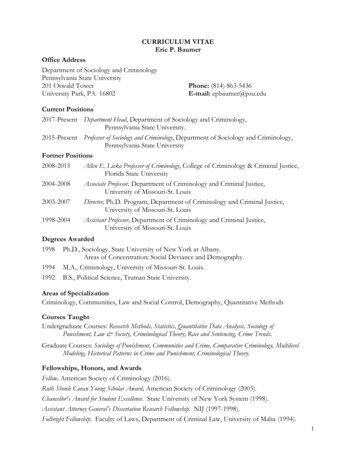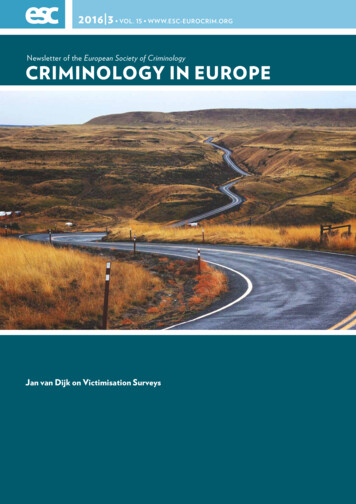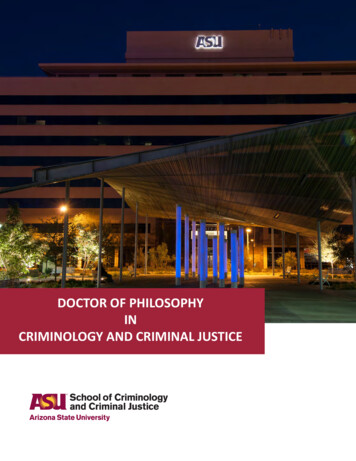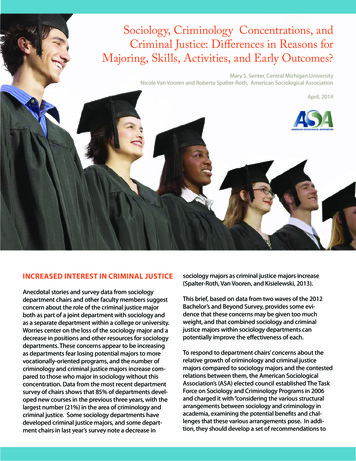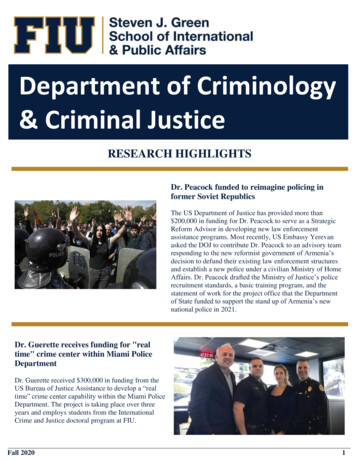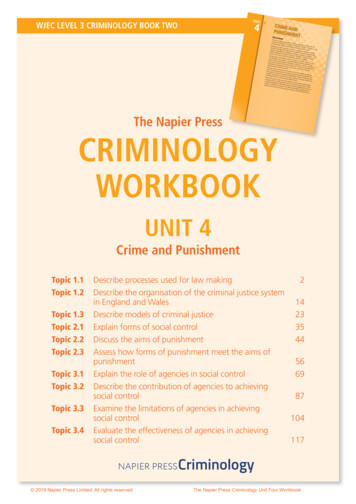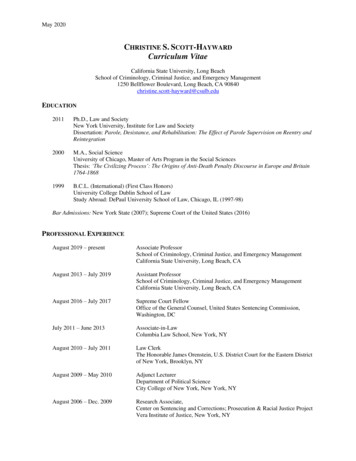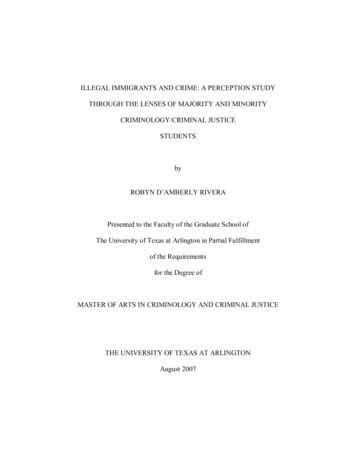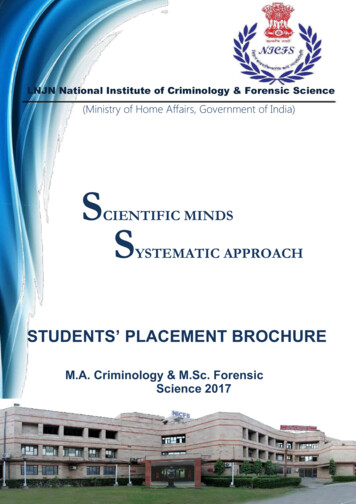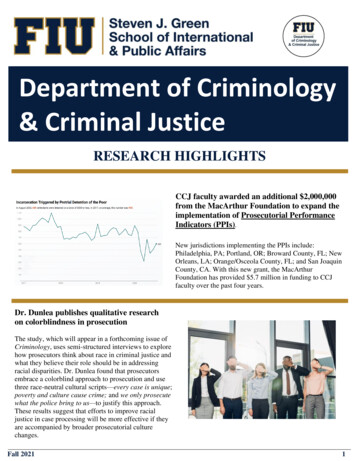
Transcription
Department of Criminology& Criminal JusticeRESEARCH HIGHLIGHTSCCJ faculty awarded an additional 2,000,000from the MacArthur Foundation to expand theimplementation of Prosecutorial PerformanceIndicators (PPIs).New jurisdictions implementing the PPIs include:Philadelphia, PA; Portland, OR; Broward County, FL; NewOrleans, LA; Orange/Osceola County, FL; and San JoaquinCounty, CA. With this new grant, the MacArthurFoundation has provided 5.7 million in funding to CCJfaculty over the past four years.Dr. Dunlea publishes qualitative researchon colorblindness in prosecutionThe study, which will appear in a forthcoming issue ofCriminology, uses semi-structured interviews to explorehow prosecutors think about race in criminal justice andwhat they believe their role should be in addressingracial disparities. Dr. Dunlea found that prosecutorsembrace a colorblind approach to prosecution and usethree race-neutral cultural scripts—every case is unique;poverty and culture cause crime; and we only prosecutewhat the police bring to us—to justify this approach.These results suggest that efforts to improve racialjustice in case processing will be more effective if theyare accompanied by broader prosecutorial culturechanges.Fall 20211
Dr. Pires leads international team ofresearchers on study of wildlife poaching inIndonesiaHigh demand for parrots as pets, and their consequentremoval from the wild, has significantly contributed totheir severe decline worldwide. Using over twodecades of data on the illegal parrot trade, Dr. Pires andresearchers from Australia and Indonesia applied thecriminological model, CRAAVED, to betterunderstand poaching variation of Indonesian parrotspecies. The study, published in BiologicalConservation, found both demand- and opportunitybased factors partially explain the illegal parrot trade inIndonesia.Dr. Kutateladze publishes researchhighlighting the socio-behavioralconsequences of queer hate crimevictimizationThe study, published in Justice Quarterly, found that23% of victims changed housing, 13% startedavoiding queer venues/friends, and 35% started actingstereotypically “straight.” The study also addressesthe pros and cons of adopting the intersectionalityperspective in quantitative research and the threestage venue-based sampling strategy used to recruitstudy participants.Dr. Flexon and Ph.D. candidate TeresaEncalada investigate the antecedents ofsecondary-like psychopathyLittle is known about the emergence of secondary-likepsychopathy despite early theory describing possibleantecedents to the condition. The study sought to evaluatethese possible precursors among those resembling thesecondary-like variant of psychopathy in anoninstitutionalized sample of youth. Findings indicatedthat social context variables (poverty and maternaleducation), authoritarian parenting practices, and parent–child attachment were implicated in later downstreamsecondary-like psychopathy in mid-adolescence.Fall 20212
Dr. Zgoba publishes meta-analysis on the(in)effectiveness of sex offender registry andnotification (SORN) lawsThe study, published in the Journal of ExperimentalCriminology, examines 25 years of Sex OffenderRegistration and Notification (SORN) evaluations andtheir effects on recidivism. Dr. Zgoba and her co-authorsynthesized results from 18 research articles including474,640 formerly incarcerated individuals. The metaanalysis demonstrated that SORN does not have asignificant impact on recidivism. This finding holdsimportant policy implications given the extensiveadoption and net-widening of penalties related to SORN.Ph.D. Candidate Caroline Comerfordinvestigates the geographic mobility of homicideoffenders in new studyMost offenders commit crime close to their residence,though literature on serial homicide and geographicmobility is scarce. To gain a better understanding of thegeographic mobility patterns of serial homicide offenders,literature sources on serial homicide and geographicmobility were examined. While the findings of the studyrecognize the relevance of mobility functions in serialhomicide investigations, gaps in the literature were evidentregarding serial homicide geographic mobility.Drs. Cruz, D’Alessio, and Stolzenbergexamine the effect of air pollution onviolent criminal behaviorThe study, published in the British Journal ofCriminology, examines the effect of carbonmonoxide emissions on physical violence exhibitedby offenders during the commission of a crime.Results show that while carbon monoxideemissions have little effect on the overall level ofphysical violence displayed by a criminal offender,both the offender’s race and sex moderate therelationship between air pollution and victiminjury. Specifically, as carbon monoxide levels risein a city, both Black and male offenders are morelikely to injure their victims physically.Fall 20213
Dr. Goddard publishes study callingattention to the limitations of using riskassessment instruments to predict recidivismRisk assessments rely on information about pastbehavior (e.g., criminal history) and an understanding ofoffending (e.g., antisocial personality) that is thought tobe neutral and reliable. Dr. Goddard, however, argues inhis study, published in Sustainability, that riskassessment instruments inevitably mark some groups ofpeople as a higher risk to violate rules, conditions,orders, or laws. Consequently, these instrumentssystematically disfavor disadvantage, and by inference,favor advantage, leading to the need for a radical shift inthe taxonomy of classifying risk for future misconduct.Drs. Ammons-Blanfort, D’Alessio, andStolzenberg examine the effect of the racialdiversity of a city’s police department on Blackfirearm violenceThe study, published in Crime & Delinquency, found thatas the racial diversity of a city’s police departmentincreased, Black criminal offenders were less likely to usea firearm in a violent crime. In contrast, the racialdiversity of a police department had no impact on the useof firearms by white offenders. The researchers concludedthat hiring more Black police officers can serve as apragmatic policy to help attenuate black firearm violenceby amplifying Black citizens' trust in the police.Dr. Liu leads study establishing a linkbetween criminal case processing times andpunitiveness in sentencing outcomesTo date, the role of case processing efficiency indetermining punishment outcomes has garnered littleattention in the criminological literature. Using recentdata from a large Florida jurisdiction, the study,published in Crime & Delinquency, examined theinfluence of case screening and disposition timelinesson sentence outcomes in felony cases. Results showedthat lengthier case processing time is associated with theassignment of lengthier custodial sentences.Fall 20214
CCJ faculty awarded 760,000 grant fromthe Schusterman Foundation to support newCommunity-Prosecutor-Researcher ProjectThe two-year grant, led by CCJ senior fellow MelbaPearson, will serve to increase interactions andcommunications between local prosecutor’s offices andthe communities they serve. This will include a series ofcommunity “listening sessions” and the development ofa blueprint for jurisdictions to utilize in the future tobetter connect with their local community organizationsand residents.Dr. Cohn leads study on scholarly influencewithin the fields of criminology and criminaljusticeDr. Cohn led a team of researchers investigating changes inscholarly influence in criminology and criminal justiceover a 30-year period. The study, recently published in theJournal of Criminal Justice Education, found that themost-cited scholars in criminology journals focused onlongitudinal/criminal career research and/or criminologicaltheories. The most-cited scholars in criminal justicejournals focused on these topics or on criminal justiceissues such as rehabilitation and sentencing. It was alsoobserved that an intergenerational transmission ofinfluence from older to younger scholars occurred throughmentoring.Ph.D. candidate Raymond Partin investigatesthe link between teen sleep and arrestIn recent years, sleep quantity and quality has receivedincreased scrutiny with respect to criminologically relevantoutcomes. No attention, however, has been given to thepossible relationship between sleep duration and thelikelihood of arrest among teens. The study, published inCrime & Delinquency, analyzed data collected from50,000 youth in Florida in 2018. The results showed thatsevere sleep deficiencies (i.e., getting four or five hours ofsleep at night) are associated with a greater likelihood ofarrest, whereas minor deficiencies in sleep and excesssleep is not.Fall 20215
CCJ faculty awarded 200,000 by Microsoft toimplement the Prosecutorial PerformanceIndicators in jurisdictions across ColoradoThe funded project entitled, “Implementing ProsecutorialPerformance Indicators in Colorado: Developing aStatewide Model of Reform,” represents the first time thatthe PPIs will be implemented across an entire state. Theproject is being conducted in coordination with faculty atLoyola University Chicago.Dr. Guerette co-edits new book on humansmuggling and drug traffickingThe book, titled The evolution of Illicit Flows:Displacement and Convergence among TransnationalCrime, is co-edited with Drs. Ernesto U. Savona andAlberto Aziani of Transcrime. It focuses on thedisplacement and convergence of transnational crimesin North Africa and in the area of the MediterraneanSea, providing empirical analysis of human smugglingand drug trafficking. It also discusses the displacementof crime due to the exploitation of asymmetries inlegislation, law enforcement, and other geo-politicalvulnerabilities. The book is set to be released bySpringer Publishers in early 2022.Dr. Peacock investigates the factorsassociated with police legitimacy acrossEuropeThe study examined the relative influence ofprocedural justice, effectiveness, and corruption inshaping police legitimacy across 26 Europeancountries. The findings of the study, published inPolice Practice and Research, revealed thatcorruption and procedural justice explained nearlyequal portions of the variance of legitimacy across asubset of Europe’s most stable and prosperousdemocracies. A greater role for effectiveness amongthe transitioning states in Europe offers support forsimilar findings in the Global South. Europe-wide,procedural justice, police effectiveness, andcorruption were three pillars contributing most oflegitimacy’s explained variance.Fall 20216
Dr. Meldrum leads study on the causes ofdigital self-harm among Florida teensResearch on the causes of digital self-harm – theanonymous posting of hurtful or negative informationabout oneself on the internet and social media platforms– is in early stages of development. Using data collectedin 2019 from nearly 10,000 FL students, Dr. Meldrumled a study that provides strong evidence that bullyingvictimization, and the subsequent negative emotionsstemming from getting bullied, are important potentialcauses of digital self-harm. The study was recentlypublished in Deviant Behavior.OTHER RECENT FACULTY* AND PH.D. STUDENT** PUBLICATIONSPyrooz, D. C., Melde, C., Coffman, D. L., & Meldrum,R. C.* (2021). Selection, stability, and spuriousness:Testing Gottfredson and Hirschi's propositions toreinterpret street gangs in self‐control perspective.Criminology, 59, 224-253.Diaz, M.** (2021). Exploring Multiple-PerpetratorStalking: Victim Consequences of Solo and MultipleStalkers. Victims & Offenders. OnlineFirst.Torres, C. E.**, D’Alessio, S. J.*, & Stolzenberg, L.*(2021). The Replacements: The Effect of IncarceratingDrug Offenders on First-Time Drug Sales Offending.Crime & Delinquency, 67(3), 449-471.Cohn E. G.*, Coccia M., and Kakar S*. (2021). Therelationship between crime, immigration andsocioeconomic factors. Rassegna Italiana diCriminologia, XV, 3, 180-193.Archer, R. J. L., and Flexon, J. L.* (2021).Unstructured Socializing With Peers and Delinquency:The Role of Mediation Through the Lens of Akers’(1998) Social Structure Social Learning Theory ofCrime and Deviance. American Journal of CriminalJustice. OnlineFirst.Guerette, R. T.*, Przeszlowski, K.**, Lee-Silcox, J.**,and Zgoba, K. M.* (2021). Improving policing throughbetter analysis: an empirical assessment of a crimeanalysis training and enhancement project within an urbanpolice department. Police Practice and Research, 22(4),1425-1442.Palmer, N. A., and Kutateladze, B. L.* (2021). WhatProsecutors and the Police Should Do AboutUnderreporting of Anti-LGBTQ Hate Crime. SexualityResearch and Social Policy. OnlineFirst.Liu, L.*, and Visher, C. A. (2021). Decomposition of therole of family in reentry: Family support, tension, Gender,and reentry outcomes. Crime & Delinquency, 67(6-7),970-996.Peacock, R.* (2021). Bayley’s six critical elements ofdemocratic policing: evaluating donor-assisted reform inArmenia, Georgia, and Ukraine. International Journal ofComparative and Applied Criminal Justice. OnlineFirst.Leimberg, A.**, & Lehmann, P. S. (2020). UnstructuredSocializing with Peers, Low Self-Control, and SubstanceUse. International Journal of Offender Therapy andComparative Criminology. OnlineFirst.The Department of Criminology and Criminal Justice offers a Ph.D. in International Crime andJustice, a M.S. in Criminal Justice, a B.S. in Criminal Justice, and a B.S. in Crime Science. Foradditional information, please visit us online at ccj.fiu.edu.Fall 20217
Comparative and Applied Criminal Justice. OnlineFirst. Leimberg, A.**, & Lehmann, P. S. (2020). Unstructured Socializing with Peers, Low Self-Control, and Substance Use. International Journal of Offender Therapy and Comparative Criminology. OnlineFirst. The Department of Criminology and Criminal Justice offers a Ph.D. in International Crime and
